Search for:
ASIAN
CANADIANS
> Museums
.jpg) Bata Shoe
Museum
Bata Shoe
Museum
Originally on view at the Bata
Shoe Museum between March 2006 and October 2007, Watched by Heaven,
Tied to Earth: Summoning Animal Protection for Chinese Children
explored animal power in Chinese footwear and costume.
The highly-acclaimed exhibition
Watched by Heaven featured over 200 beautifully crafted Chinese
children's shoes and garments, drawn largely from the private
collection of Mr. Glenn Roberts, other private collections and
from the Bata Shoe Museum, with the majority of pieces never
before displayed in Canada. The exhibition explored the many
meanings and symbolism that Chinese mothers and grandmothers
used to protect their precious children. The abundance of colours
and textures drew visitors into a playful world ruled by sewn,
painted, appliquéd, and embroidered animals.
For more than three thousand
years, animals helped define Chinese political, social and personal
identity. Associated with the directions, the seasons, time of
life, heavenly bodies, the years of the zodiac, gods and heroes
of legends, animals were part of a rich symbolic language that
conveyed wishes for happiness, good fortune, and protection for
all members of the family, especially children.
During the first critical years
of life, Chinese mothers, grandmothers and aunts traditionally
dressed children in shoes and clothes that imitated the hides
of especially powerful animals. These garments, decorated with
bared fangs and teeth to intimidate evil spirits and with long
whiskers to symbolically tie children's lives to earth symbolized
animal protection.
Through an astonishing array
of shoes, hats, bibs and accessories dating from the mid-19th
century to the present, the exhibition explored these long-standing
traditions and beliefs, which continue to resonate in China.
These objects offered visitors insight into one of the world's
oldest continuing cultures.
Designed as a traditional Chinese
courtyard, the gallery welcomed visitors with two of the most
frequently used protectors: the tiger and the dragon. Representing
yin and yang respectively, these animals helped to ward off evil
by invoking Heaven's watchful eye. Dragon and tiger booties for
infants and tiger shoes for toddlers were the most popular animal
garments worn by Chinese children, helping protect their tiny
lives by bringing yin and yang into balance.
The Chinese zodiac was another
element which played largely in the lives of children and on
their clothing. Based on the year of one's birth, the twelve
signs represented a variety of personality characteristics and
influences that determined one's fortunes. Shoes, hats, bonnets,
bibs and pocket purses for infants and toddlers bearing images
of the twelve zodiac animals were the central feature of the
exhibition. Arrayed in sequence by birth year, these objects
illuminated the traits and destinies of their owners.
Glenn Roberts, who generously
loaned the majority of pieces in the exhibition, wanted visitors
to first and foremost enjoy the artifacts. "They are charming
examples that make you giggle," said Roberts, "but
they are more than that." Roberts continued, "I wanted
the visitor to look at the artifacts and not only enjoy them
but also try to understand how the Chinese used symbolism and
imagery to depict wishes and beliefs for their children."
Augmenting the displays of
artifacts were photographs, paper cuts, and a video illustrating
how shoes and garments were made and worn. A children's activity
area featured Chinese masks, puppets, games and animal picture
books.
About the Bata Shoe Museum
The Bata Shoe Museum is dedicated to uncovering the role of footwear
in the social and cultural life of humanity. The Museum's growing
international collection of over 13,000 objects touches on 4,500
years of history. A varied programme of events and exhibitions
lets visitors discover the stories behind footwear from many
lands and cultures. Current exhibitions include: Beauty, Identity,
Pride: Native North American Footwear, Chronicles of Riches:
Treasures from the Bata Shoe Museum, All About Shoes: Footwear
Through the Ages and Star Turns, a celebrity exhibition. The
Bata Shoe Museum is located in downtown Toronto at 327 Bloor
Street West, at the southwest corner of Bloor and St. George
Streets. Further information is available at www.batashoemuseum.ca.
Major Exhibition Lender
- Glenn Roberts, New York
Described in the media as a "collector with a wonderful
eye for underappreciated Chinese folk art", Glenn Roberts
has always been fascinated with what people wear and why. A collector
since childhood - he was initially intrigued by the various Native
American Indian tribes and how each group was unique in terms
of colour and dress - his fascination with different cultures
led him to build one of the world's largest collections of Chinese
lotus shoes.
A fashion and beauty industry
expert for over 30 years, Mr. Roberts began his career first
as a designer for a variety of fashion houses, and later as the
creative director and public relations spokesperson for Elizabeth
Arden. A beauty and fashion consultant for a former popular television
program, Toronto Today, he has also produced numerous editorials
for Canadian magazines such as Chatelaine.
Many of Mr. Roberts' artifacts
have been exhibited at the Metropolitan Museum of Art, the American
Museum of Natural History, the Fashion Institute of Technology
Museum, the China Institute Gallery as well as smaller museums.
Mr. Roberts was not only a collector, but was also a researcher,
exhibitor, and consultant to other collectors and museums.
Glenn Roberts past away on
May 7, 2009 in New York City. The collection that he and Judy,
his wife of forty years and collaborator and partner, continues
as an invaluable resource for scholars, students and others interested
in Chinese culture.
Lead Curator - John E. Vollmer,
New York
John E. Vollmer is a distinguished curator and scholar known
internationally for his exhibitions and publications in the fields
of Asian textiles and costume, decorative arts and design. President
of Vollmer Cultural Consultants Inc., he directs major projects
with museums, private collectors and advises auction houses in
North America, Asia and Australia. Vollmer has served as director
and senior curator in museums, universities and cultural agencies
in Canada and the United States.
Educated at Columbia University
(B.A.), Harvard and the University of Toronto (M.A.), John Vollmer
has held senior curatorial appointments at the Royal Ontario
Museum, Toronto, and at the Glenbow Alberta Museum, Calgary.
He served as director at the Kent State University Museum, Kent,
Ohio and was the founding executive director of the Design Exchange
in Toronto. He also teaches and has held appointments at universities
including the University of Toronto, The School of the Art Institute
of Chicago, Nova Scotia College of Art and Design, Dortmund University
and Fu Jen Catholic University in Taipei.
Vollmer's recent Museum
projects include:
- Textile Galleries, Southern Branch, National Palace
Museum, Taipei, Opened 2008
- Patricia Harris Textile
and Costume Gallery, Royal Ontario Museum, Opened 2006
- Watched by Heaven, Tied
to Earth: Summoning Animal Protection in Chinese Children, Bata Shoe Museum, Opened 2006
Vollmer's most recent publications
on imperial Chinese costume and textiles include:
- Emblems of Empire: Selections
from the MacTaggart Art Collection, Edmonton, University of Alberta
Press, 2009
- Dressed to Rule: 18th Century
Court Attire in the Mactaggart Collection, Edmonton, University
of Alberta Press, 2007
- Ruling from the Dragon Throne
Costume of the Qing Dynasty (1644-1911), Berkeley, Ten Speed
Press, 2003
Watched by Heaven gallery image
© 2009 Bata Shoe Museum, Toronto
(photo: Victor Yeung)
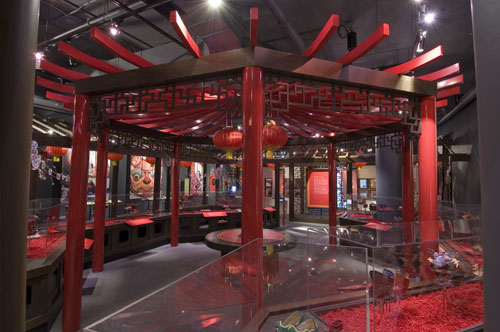 Bata Shoe Gallery -
Credit: Bata Shoe Museum. Photographer: Victor Yeung
Bata Shoe Gallery -
Credit: Bata Shoe Museum. Photographer: Victor Yeung
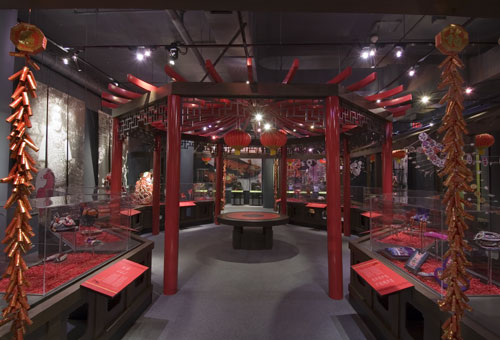 Bata Shoe Gallery -
Credit: Bata Shoe Museum. Photographer: Victor Yeung
<< top
Bata Shoe Gallery -
Credit: Bata Shoe Museum. Photographer: Victor Yeung
<< top
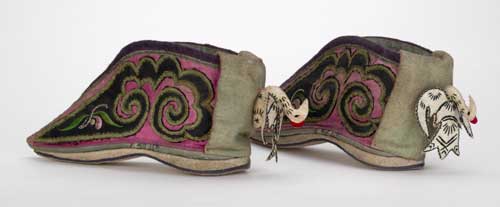 Crane Shoes - Credit:
Bata Shoe Museum. Photographer: Hal Roth
Crane Shoes - Credit:
Bata Shoe Museum. Photographer: Hal Roth
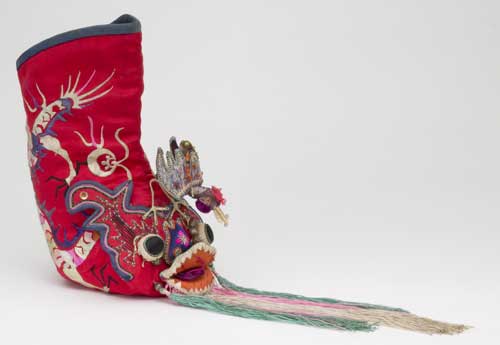 Dragon Shoes - Credit:
Bata Shoe Museum. Photographer: Hal Roth
Dragon Shoes - Credit:
Bata Shoe Museum. Photographer: Hal Roth
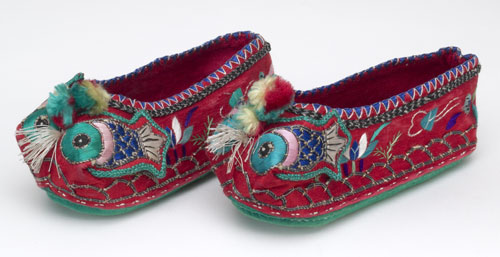 Fish Shoes - Credit:
Bata Shoe Museum. Photographer: Hal Roth
<< top
Fish Shoes - Credit:
Bata Shoe Museum. Photographer: Hal Roth
<< top
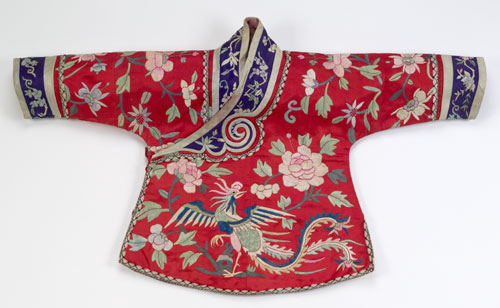 Phoenix Coat - Credit:
Bata Shoe Museum. Photographer: Hal Roth
Phoenix Coat - Credit:
Bata Shoe Museum. Photographer: Hal Roth
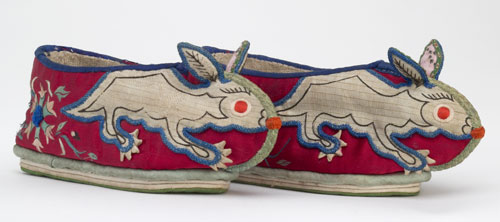 Rabbit Shoes - Credit:
Bata Shoe Museum. Photographer: Hal Roth
Rabbit Shoes - Credit:
Bata Shoe Museum. Photographer: Hal Roth
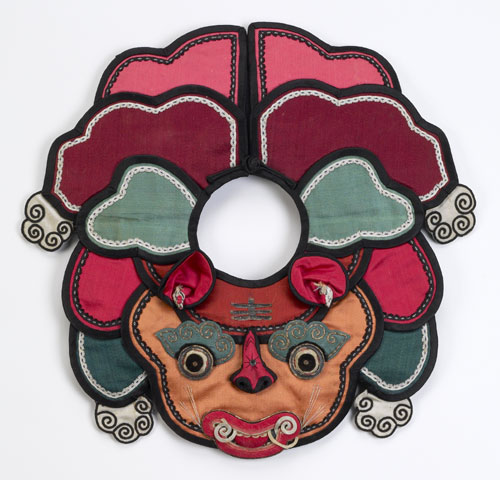 Tiger Bib - Credit:
Bata Shoe Museum. Photographer: Hal Roth
<< top
Tiger Bib - Credit:
Bata Shoe Museum. Photographer: Hal Roth
<< top
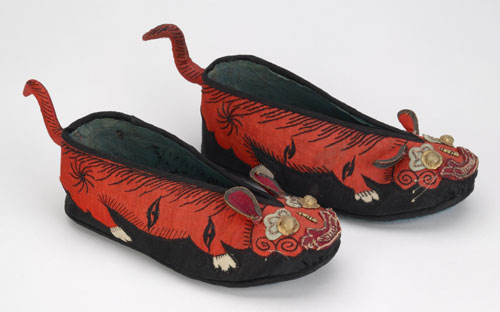 Tiger Shoes - Credit:
Bata Shoe Museum. Photographer: Hal Roth
Tiger Shoes - Credit:
Bata Shoe Museum. Photographer: Hal Roth
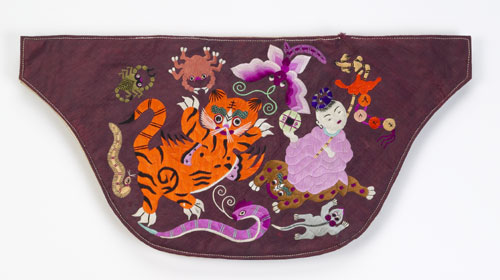 Tiger Bib - Credit:
Bata Shoe Museum. Photographer: Hal Roth
<<
top
Tiger Bib - Credit:
Bata Shoe Museum. Photographer: Hal Roth
<<
top
 The project was made
possible with the support of the
The project was made
possible with the support of the
Department
of Canadian Heritage through the Canadian Culture Online Strategy
The Acrobat Reader
is available free from 